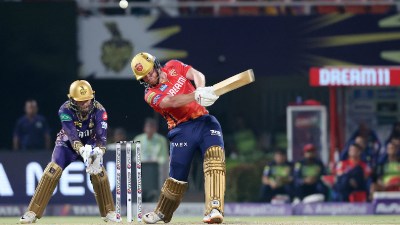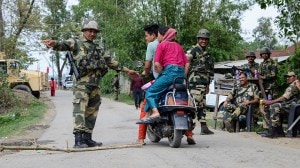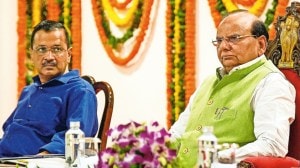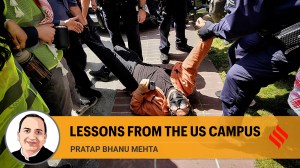- India
- International
Potato, three years of losses to count in 4 out of 8 seats voting next in Uttar Pradesh
Potato is a major crop in Agra, grown in 57,879 hectares of the district (2017-18 data) that includes both Agra and Fatehpur Sikri. The tuber is also extensively cultivated in Hathras (46,333 hectares) and Aligarh (23,332).
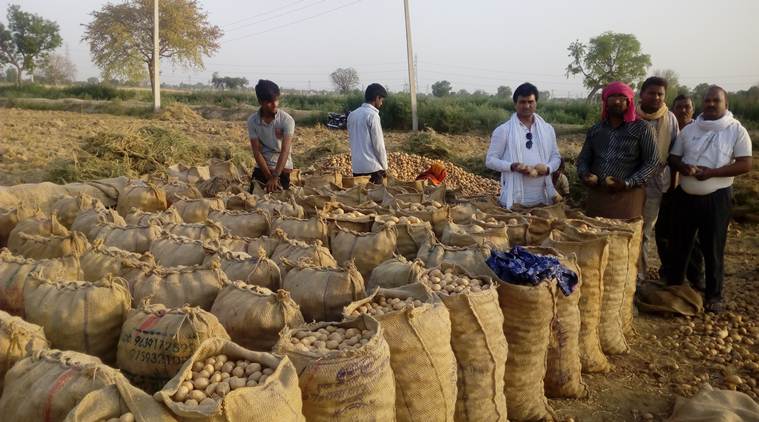 At a potato farmer’s field near Agra. (Express Photo: Harish Damodaran)
At a potato farmer’s field near Agra. (Express Photo: Harish Damodaran)
If it was ganna (sugarcane) in the first, it’s aloo (potato) that could be decisive in at least four of the eight Lok Sabha constituencies of Uttar Pradesh voting in the second phase on April 18.
Potato is a major crop in Agra, grown in 57,879 hectares of the district (2017-18 data) that includes both Agra and Fatehpur Sikri. The tuber is also extensively cultivated in Hathras (46,333 hectares) and Aligarh (23,332). While polls to these four southwest UP seats are on April 18, the other three big aloo constituencies vote later: Firozabad (48,589 hectares) on April 23, and Kannauj (50,089) and Farrukhabad (35,168) on April 29.
“Yahan ka mudda aloo hi hai (the main issue here is potato),” says Pradeep Sharma, whose family jointly farms 27 bigha (15 acres) in Nagla Nathu village falling in Fatehpur Sikri constituency. Nagla Nathu has about 800 voters, comprising an estimated 300 Rajputs and 100 each from the Brahmin, Prajapati (potter), Baghel (shepherd) and Jatav Dalit communities.
The 39-year-old Sharma, a Brahmin, makes no secret of his displeasure at potato prices. “Mota aloo (normal large potato) is being sold from our fields at Rs 300-350 per 50-kg bag (Rs 6-7/kg), while it is Rs 200-250 for gulla (medium) and Rs 100-150 for kirri (small) varieties. And the rates have been low for more than three years now, especially after notebandi (demonetisation),” he complains.
Sharma voted for the BJP in the 2014 Lok Sabha and 2017 UP Assembly elections. This time, he is backing Raj Babbar, the Congress candidate from Fatehpur Sikri. “Ninety per cent Brahmins in my village are voting for the Congress. So are more than 50 per cent Thakurs,” he claims, pointing to Brijesh Kumar Jadon (45), a 9-bigha Rajput farmer, who nods his head.
Click here for more election news

Potato is sown in these parts from October 15 to November 5 and harvested in February 20-March 10. Farmers generally sell only around a fifth of their crop at harvest time, in order to pay labourers and meet other immediate expenses. The remaining produce they deposit in sheet bhandar (cold stores) — where the tubers are maintained at 2-4 degrees Celsius — for making staggered sales till November-end. The bhandar owners charge roughly Rs 110 per bag, which farmers have to pay irrespective of the number of days the potatoes are stored. The bulk of sales to traders take place right at the cold stores.
According to Rajesh Goyal, president of the Cold Storage Association of UP, Agra district alone has some 280 sheet bhandars that can store an average 10,000 tonnes each, while Aligarh and Hathras together have 300 (7,500-tonnes average capacity) and Firozabad another 200 (7,500). He reckons that out of UP’s 1,800-odd cold stores, nearly 1,000 are in just two divisions: Agra (Agra, Firozabad, Mainpuri and Mathura districts) and Aligarh (Aligarh, Hathras, Etah and Kasganj).
Before November 8, 2016, when demonetisation happened, potato prices at Agra’s cold stores were Rs 600-700 per bag. With the scrapping of the old Rs 500 and Rs 1,000 currency notes, there weren’t any takers for the stocks lying at the cold stores, which usually down for maintenance by November-end. These had to be disposed of at Rs 100-125/bag, while the gulla and kirri potatoes were given away practically free.
The real problems, however, came with the 2016-17 crop, which were sold at Rs 200-210/bag during the time of harvest. Given the low realisations, farmers put more than 90 per cent of their produce in cold stores, expecting rates to recover in the months ahead. Instead, they remained depressed throughout 2017, so much so that farmers did not even bother to re-claim their potatoes, whose prices couldn’t cover the rentals and interest on credit, extended by the bhandar owners themselves.
In February-March 2018, prices were somewhat better at Rs 500-550 per bag. They rose to Rs 600-650 levels from April to September and crossed Rs 700 towards October. But since November, after Diwali, the bear cycle has resumed, with mota aloo rates in cold stores collapsing to Rs 200-250 in December. They ruled at Rs 400-450 in February-March 2019 and are currently at Rs 500-550.
“The last three crop years (four, if the latter part of 2016-17 is included) have been a disaster, both for farmers and us. Traders aren’t coming to buy from cold stores like before. Bazaar mein na paisa hai na uchchal hai, aur nikaas nahin ho raha hai (there’s neither money nor sentiment in the market, due to which the stocks are not moving out),” says Doongar Singh Chaudhary, owner of Vaidyaji Sheetgrah Pvt. Ltd, a bhandar at Khandauli in Agra district’s Etmadpur tehsil.
Chaudhary’s store can stock 250,000 bags (12,500 tonnes) of potatoes, which includes over 22,000 bags from his 90-acre holding (60 own and 30 leased). He is among the many farmers-turned-cold store owners — mostly Jats — whose bhandars dot the stretch from Khandauli to Sadabad-Hathras-Sasni and Iglas in Aligarh.
“The bare cultivation cost of potato is Rs 90,000 per acre. That, at an average yield of 11.5-12 tonnes, works out to Rs 7.5-8 per kg. Adding cold store rental, it comes to Rs 9.5-10/kg or Rs 475-500/bag. We are used to low prices once in three years, but three consecutive years of losses is something no farmer can bear,” states Mohammad Alamgir, general secretary of the Potato Growers Association in Agra.
Aloo growers aren’t an organised “lobby” like their ganna counterparts. “But we will make sure that our votes count in this election,” he adds.
Apr 27: Latest News
- 01
- 02
- 03
- 04
- 05











